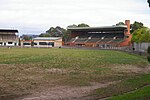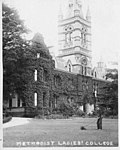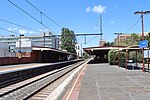Barker railway station
Disused railway stations in MelbourneMelbourne rail transport stubsRailway stations closed in 1952Railway stations in Australia opened in 1887Use Australian English from February 2015 ... and 1 more
Victoria (Australia) railway station stubs
Barker railway station was the only intermediate station on the Kew railway line in Melbourne, Australia. It was opened on 19 December 1887 and closed with the line on 13 May 1957. The station was located between Barkers Road and Hawthorn Grove and has since been demolished.
Excerpt from the Wikipedia article Barker railway station (License: CC BY-SA 3.0, Authors).Barker railway station
Hawthorn Grove, Melbourne Hawthorn
Geographical coordinates (GPS) Address Nearby Places Show on map
Geographical coordinates (GPS)
| Latitude | Longitude |
|---|---|
| N -37.8147 ° | E 145.0299 ° |
Address
Hawthorn Grove
Hawthorn Grove
3122 Melbourne, Hawthorn
Victoria, Australia
Open on Google Maps







